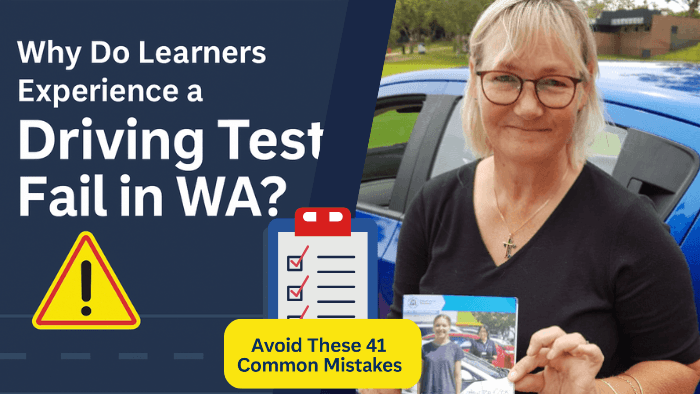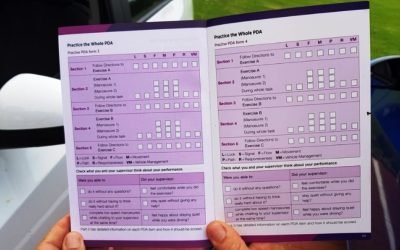Getting ready for your driving test in Western Australia can feel exciting, but also a bit nerve-wracking. You’re not alone in that.
A driving test fail in Western Australia is more common than you might think. And knowing why it happens can help you prepare better.
The Practical Driving Assessment (PDA) is a one-on-one assessment where a driving assessor watches how you drive in real traffic. They want to see that you can drive safely, follow the road rules, and make smart decisions under pressure.
It’s not about driving perfectly. Mistakes are allowed in practical driving test as long as they don’t affect safety. It’s about being safe and consistent behind the wheel.
Most people don’t pass the first time. That’s okay. What matters is learning from what goes wrong so it doesn’t happen again. One of the best ways to prepare is by understanding the most common reasons people fail their PDA in WA. When you know what trips others up, you can work on those areas early in your lessons to pass your driving test with more confidence when it’s your turn.
Before I will go into the details, let’s start with the list first. Then, keep reading for more instructions.
List of Common Reasons for Failing the Practical Driving Assessment PDA
- Not stopping completely at stop signs
- Inadequate observation at intersections
- Speeding (even slightly)
- Failing to give way
- Poor gap selection
- Lack of mirror checks
- Not signalling properly
- Mounting the kerb
- Stalling the vehicle
- Poor vehicle control
- Failing to maintain a safe following distance
- Confusion with roundabouts
- Parking mistakes
- Failure to respond to hazards
- Failing to wear a seatbelt before starting the engine
- Colliding with another vehicle or object
- Causing another road user to take evasive action
- Disobeying a traffic light
- Entering a roundabout unsafely
- Disobeying a direction from the assessor
- Driving on the wrong side of the road
- Dangerous lane changes
- Failing to stop for school crossings or pedestrians
- Repeated stalling
- Clutch coasting (in manual cars)
- Hesitation (waiting too long to turn or merge)
- Incorrect road positioning
- Cutting corners
- Wide turns
- Unnecessary stopping
- Failing to cancel your indicator
- Harsh or late braking
- Over-reliance on the assessor
- Missing blind spot checks
- Rolling backwards on hill starts
- Improper use of gears
- Over-speeding downhill
- Misreading road signs or markings
- Crossing solid white lines
- Driving too slowly
- Blocking intersections
✅ Tip from Lisa at Dovetail
“Make your seatbelt, mirrors, and safety checks part of your driving routine. Before the engine even starts.”
As you see, there is a long list of reasons many learners fail. Even if the road looks clear, you must come to a complete stop: wheels must stop moving at a stop sign or stop line. Slowing down isn’t enough. This is marked as a Critical Error and can result in immediate failure.
Small mistakes quickly add up in a test setting. One missed mirror check, or one slow decision at a roundabout, can lead to a fail. But here’s the good news: these are all things we can work on together during your lessons.
Whether you’re a teen working on your logbook hours, a parent helping your child get ready, someone who’s returning after a long break, or a new Australian adjusting to WA roads, I meet you where you’re at. My beginner driving lessons. Some parts of driving take longer to click. Parking, clutch control, right turns in busy traffic. It’s normal to struggle at first. Don’t get discouraged. We’ll keep working on it until it makes sense to you. are step by step, not rushed, and always include clear feedback you can understand.
A calm, confident driver is a safer driver. That’s what the test is looking for. And that’s what we work towards from the very first lesson.
In the sections ahead, I’ll walk you through the most common reasons people fail their WA driving test, other frequent mistakes to watch for, and how to manage your anxiety so you can give your best effort on the day. You’ll also find advice for new migrants and some encouraging tips from my years of teaching here in Western Australia.
Let’s help you drive with confidence and pass that test.
The Most Common Reason for Driving Test Fail in WA
Inadequate observation is the number one reason learners fail their driving test in Western Australia.
This means not checking your mirrors regularly, forgetting to do head checks, or missing what’s happening at intersections, roundabouts, and pedestrian crossings. These small slips matter. Assessment officers are watching to see if you are aware of your surroundings at all times. If you miss a check and make a mistake, they will count it against you.
One of the most common spots where this happens is at the turn-right intersections, especially where there’s no specific arrow light. Learners often don’t notice oncoming traffic properly or forget to re-check before committing to the turn. Another danger area is merging lanes. Failing to spot a car in your blind spot is a big safety risk. That’s why observation is such a key part of the test.
You might know how to steer, brake, and control the car. But if you’re not showing that you’re aware of what’s around you, the assessor won’t pass you. They need to be confident that you can keep yourself and others safe on WA roads. Good observation shows responsibility and maturity in your driving.
How to Strengthen Your Observations
- Mirror checks: Do them before changing speed, lanes, or direction.
- Head checks: Always check your blind spot when merging or pulling out.
- Look early: Scan crossroads, driveways, and roundabouts before you get there.
- Be deliberate: Make your movements clear. Don’t rush or just swivel your eyes. Turn your head.
This takes practice. It’s not about memorising steps. It’s about building habits that feel natural.
When we work together during lessons, I’ll guide you on when to look, what to look for, and why it matters. Every learner is different, and we take the time to help your observation skills become second nature. It just takes calm, repeated practice and a little trust in yourself.
Strong observation is the foundation of safe driving, and it’s the first skill I look for in every lesson.
Other Frequent Mistakes to Avoid
Once you’ve got your observation skills sorted, there are a few more areas that can trip you up on test day. These are common mistakes learners make during their Practical Driving Assessment in WA. Some seem small but can still lead to a fail if they affect safety or show lack of control.
Poor Clutch Control (Manual Drivers)
If you’re driving a manual car, smooth clutch use is a must. Jerky starts, stalling, or rolling backwards on a hill are warning signs for the assessor. To improve this:
- Practice finding the friction point until it becomes second nature.
- Use the handbrake on slopes to avoid rolling back.
- Keep your left foot steady when taking off, especially in traffic or at intersections.
Incorrect Lane Positioning
You need to stay in the correct lane, not too close to the kerb, parked cars, or the centre line. On multi-lane roads, picking the wrong lane or drifting between lanes can be marked down. Here’s how to fix it:
- Stay centred in your lane using gentle steering.
- Know your lane early before turning or changing direction.
- Always check signs and road markings to guide you.
Failure to Signal or Incorrect Signalling
Not signalling, signalling too late, or forgetting to cancel your signal are common mistakes. The assessor is looking to see if you clearly show your intentions every time. To avoid this:
- Signal at least three seconds before turning or changing lanes.
- Cancel your signal if it stays on after a turn or merge.
- Use signals every time, even in quiet or empty streets.
Speeding or Driving Too Slowly
Going over the limit is an instant test fail in many cases. But going too slow can also lose marks, especially if it affects other traffic. To stay on track:
- Watch for speed limit signs; they can change quickly in suburban areas.
- Match your speed to the conditions, staying safe but keeping up with the flow.
- Glance at your speedo often to stay steady and avoid drifting over the limit.
Over-Caution or Hesitation
Being too hesitant at roundabouts, stop signs, or turns can make other drivers unsure of what you’re doing. It shows a lack of confidence or decision-making. That includes waiting too long to go when it’s safe. Here’s what helps:
- Trust your judgement once you’ve looked and seen it’s clear.
- Don’t wait for a perfect gap; act when it’s safe and legal.
- Learn how to judge timing through practice in real traffic situations.
The PDA checks how well you can move with the flow while still driving safely. If you freeze or hesitate often, it may cost you the test.
Practice builds trust in your own driving. That’s why we take time in lessons to repeat these tricky spots until you feel sure. You don’t need to be perfect, just be steady, predictable, and aware.
How Nervousness Can Affect Your Performance
Even the most prepared learners can struggle during their driving test if nerves take over.
Feeling anxious before your Practical Driving Assessment is completely normal. But nerves can lead to hesitation, rushed decisions, or forgetting simple steps you’ve already learned. Some learners freeze at intersections, forget head checks, or stop signalling because their mind is distracted by worry.
Your assessor isn’t looking for perfection. They’re checking if you can stay calm, make steady choices, and follow the rules. Anxiety can affect all of that. You might stall the car, miss a give-way sign, or drive slower than needed because you don’t trust yourself.
Nervous drivers can come across as unsafe or unready, even when they’ve practised the skills properly.
Why Staying Calm Matters
The test is about real-world driving. If you look scared or unsure, the assessor may think you’re not ready for solo driving. Staying calm helps your brain focus on the road, not on your mistakes or what the assessor might be thinking.
Confidence isn’t about being perfect. It’s about staying steady, even when something unexpected happens.
Simple Ways to Settle Your Nerves
- Breathe slowly before and during the test. Count each breath to bring your focus back to the moment.
- Arrive early so you’re not rushed. Give yourself a few minutes to sit, breathe, and collect your thoughts.
- Visualise success by picturing yourself driving calmly, using your signs, and making smart decisions.
- Practice the test route with your instructor so the roads feel familiar.
- Talk it through before the test. I’ll help you understand what to expect and remind you of your strengths.
You don’t have to get rid of all the nerves. You just need to manage them enough to drive calmly and clearly.
In our lessons, we practise more than just driving technique. We also work on ways to stay focused, even when your hands are shaky or your heart’s racing. You’ll learn calming habits that you can bring into the car with you. That includes sticking to a routine, leaning on what you’ve already learned, and reminding yourself that one mistake doesn’t mean you’ve failed.
We can practise this together, over and over, until it feels easier and less scary.
Special Considerations for New Australians and Migrants
Moving to Western Australia and learning to drive here can feel like starting from scratch. Even if you’ve had years of driving experience overseas, overseas driver’s licence conversion in WA isn’t always simple. The road rules, signs, and driving style here can take some getting used to.
For many new Australians, one of the first hurdles is driving on the left side of the road. It’s easy to slip into old habits, especially when turning or entering roundabouts. That’s why during lessons, we repeat these situations until you feel confident. We make room for small mistakes, learn from them, and practise without pressure.
New Road Rules, New Challenges
The rules here in Western Australia might be very different from what you’ve known. You’ll need to get familiar with:
- Roundabouts and who gives way
- Signage like “No Stopping,” “Give Way,” and school zones
- Speed limits that often change per area
- Indicators, merging rules, and safe following distances
Even experienced overseas drivers can feel unsure about these details during a test. That’s why we go back to the basics together, with no judgement and no rush.
Clear Explanations Make a Difference
Some migrants struggle with English or driving terms used during tests. I keep things simple so you can understand instructions, both during lessons and in your test preparation. We take extra time to explain signs, read the road together, and practise the exact language used in assessments.
If language is a barrier, bring any documents or words you need help with, and we’ll go through them together. I want you to feel comfortable asking questions as many times as you need to.
How to Work Through the Transition
- Book regular lessons to build habits the WA way, not just rely on past experience.
- Practise key driving areas like roundabouts, intersections, and school zones.
- Ask for repeated feedback so you know what to fix and how to do it right.
- Use printed resources or translated materials to review outside of lessons if needed.
You’re not starting over. You’re building on what you know and adjusting for a new road system.
Many migrants feel nervous about testing again, especially after driving most of their life. You’re not alone, and you can do this. With the right support, patient teaching, and steady practice, your goal of earning a WA driver’s licence is well within reach.
We’ll take it slowly, one roundabout, one rule, and one step at a time.
Tips from Lisa Archer for Test Success
Steady habits and calm confidence will carry you through your driving test. After teaching hundreds of learners of all backgrounds, I’ve seen firsthand what helps most.
1. Practice Often and Purposefully
It’s not just about doing your logbook hours. It’s about making those hours count. When you practise:
- Use real test areas to get familiar with tricky spots
- Mix it up: drive in heavy traffic, quiet suburbs, and near schools
- Talk through what you’re doing out loud to build awareness
You don’t need to drive every day, but you do need patterned, steady practice.
2. Know What the Assessor Is Looking For
The PDA in WA tests your decision-making, control, and observation. If you know what they want to see, it’s easier to focus on showing that in your test. We walk through these assessment points before your test, so you’re not guessing on the day.
- Safe gaps at intersections
- Correct signalling and lane use
- Consistent mirror and head checks
- Steady control of the car (whether automatic or manual)
I’ll give you simple checklists for each area, so there’s no confusion.
3. Choose an Instructor That Explains Things Clearly
A good instructor helps you feel relaxed and gives you honest feedback. That’s how I teach.
Whether you’re confused about road rules or nervous about traffic, I break it down into small steps. If you didn’t get it the first time, we try again, kindly and without pressure.
4. Stick With the Process, Even When It’s Hard
Some parts of driving take longer to click. Parking, clutch control, and right turns in busy traffic. It’s normal to struggle at first. Don’t get discouraged. We’ll keep working on it until it makes sense to you.
In every lesson, we build on what you already know. I help you notice what’s improving, not just what went wrong. You need that encouragement when doubts creep in.
You’re not expected to do it perfectly, just safely and with awareness.
5. Have a Pre-Test Plan
On the day of your test, aim to:
- Get at least 20–30 minutes of warm-up driving before your booking
- Go over any last-minute questions together
- Say a quiet prayer or take a few deep breaths if you’re feeling nervous
- Remind yourself that you’re not alone – the roads are not testing you
If something unexpected happens during the test, fix it if you can, then keep going. Don’t give up in your mind.
You don’t have to feel brave every second. You just have to keep showing up one corner, one signal, one decision at a time. And I’ll be here supporting you through the entire journey.
Conclusion
Don’t be discouraged if you fail your driving test. It’s actually very common, and it doesn’t mean you aren’t capable. The important thing is how you respond to it. Failing gives you a clear look at what skills still need work. That’s something you can grow through, not feel ashamed of.
Every learner driver has something they find challenging. For some, it’s merging. For others, it might be parking or roundabout rules. This isn’t a race. You’re allowed to take your time, make mistakes, and keep learning.
Your driving test is just one part of your journey, not the final step. What matters most is that you drive with care, learn to trust yourself, and keep showing up. With practice and patience, you will improve.
If you’ve failed before, it doesn’t mean you’ll fail again. Think of it like training. You’ve already seen how the test works.
Now we can focus on the areas that need fine-tuning. That might be observation checks, smoother signalling, or calming your nerves. Each attempt adds strength to your skills because you’re trying again with more wisdom and more practice.
Confidence grows with consistency. Show up to each lesson ready to learn, and I’ll be right beside you explaining the steps calmly and clearly. Whether it takes one try or three, we’ll keep going together. Tests don’t define your worth. They’re just checkpoints to help guide your progress.
You deserve to feel supported, not judged. That’s the heart of how I teach. We pray through doubt, we talk through tough moments, and we laugh through the confusion until it all starts to click.
Your next pass might only be one lesson away.
And guess what? Even if it’s not, you’re still on track: one signal, one reverse park, one choice at a time.
You’ve got this. And I’ve got your back. Blessings xx








Recent Comments